Feature Extraction and Mapping Construction for Mobile Robot via Ultrasonic MDP and Fuzzy Model
Abstract
1. Introduction
2. Experimental Platform Design
2.1. Configuration of Ultrasonic Array
2.2. Detected Data Analysis
3. MDP Optimization Algorithm
3.1. Analysis of Conventional RCD
3.2. MDP Optimization for Feature Extraction
4. Feature Classification Based on Fuzzy Model
4.1. Variable Definition and Language Conversion
4.1.1. Ultrasonic Distance Range
4.1.2. Boundary Definition
4.1.3. Output Feature Types
4.2. Data Fuzzification
4.3. Fuzzy Rules and Defuzzification
4.3.1. Fuzzy Rules
4.3.2. Defuzzification
5. Experiment and Verification
5.1. Distance Data Detection and Preprocessing
5.2. Feature Extraction and Classification
5.3. Mapping Construction
6. Conclusions
- (1)
- The MDP feature extraction algorithm is proposed and the least-squares polynomial curve fitting is applied to extract the minimum-distance point of the ultrasonic distance dataset. This MDP method can compensate for the feature location error in the conventional RCD algorithm.
- (2)
- A feature classification model based on fuzzy theory is established. The ultrasonic distance range and distance state detected by the ultrasonic sensor are regarded as the input of the fuzzy model. The rules of data fuzzification, reasoning, and defuzzification are defined according to practical testing experience. With the fuzzy model, the classification results—including flat surfaces, a corner, and a cylindrical feature—can be attained.
- (3)
- The object feature extraction and the mapping construction by using MDP and the fuzzy model are successfully verified by experiment. A fully accomplished case of mapping with MDP and the fuzzy model is demonstrated in our study using basic regular geometry. Compared with the physical map, the distance error constructed by the rotary ultrasonic array is 1.2 cm and the angle error is 3°, representing high accuracy of environmental mapping for indoor mobile robotics.
Author Contributions
Funding
Conflicts of Interest
References
- Truong, X.; Ngo, T.D. Toward Socially Aware Robot Navigation in Dynamic and Crowded Environments: A Proactive Social Motion Model. IEEE Trans. Autom. Sci. Eng. 2017, 14, 1743–1760. [Google Scholar] [CrossRef]
- Souza Rosa, L.; Bonato, V. A method to convert floating to fixed-point EKF-SLAM for embedded robotics. J. Braz. Comput. Soc. 2013, 19, 181–192. [Google Scholar] [CrossRef]
- Silver, D.; Morales, D.; Rekleitis, I.; Lisien, B.; Choset, H. Arc carving: Obtaining accurate, low latency maps from ultrasonic range sensors. In Proceedings of the 2004 IEEE International Conference on Robotics and Automation (ICRA), New Orleans, LA, USA, 26 April–1 May 2004; IEEE: Piscataway, NJ, USA, 2004; pp. 1554–1561. [Google Scholar]
- Hebert, M. Active and passive range sensing for robotics. In Proceedings of the 2000 IEEE International Conference on Robotics and Automation (ICRA), San Francisco, CA, USA, 24–28 April 2000; IEEE: Piscataway, NJ, USA, 2000; pp. 102–110. [Google Scholar]
- Benet, G.; Blanes, F.; Simó, J.E.; Pérez, P. Using infrared sensors for distance measurement in mobile robots. Robot. Auton. Syst. 2002, 40, 255–266. [Google Scholar] [CrossRef]
- Blanco, J.; González-Jiménez, J.; Fernández-Madrigal, J. A robust, multi-hypothesis approach to matching occupancy grid maps. Robotica 2013, 31, 687–701. [Google Scholar] [CrossRef]
- Wei, W.; Weidong, C.; Yong, W. Probabilistic Grid Map Based Localizability Estimation for Mobile Robots. Robots 2012, 34, 485–491. [Google Scholar]
- Werner, F.; Sitte, J.; Maire, F. Topological map induction using neighbourhood information of places. Auton. Robots 2012, 32, 405–418. [Google Scholar] [CrossRef]
- Du, Z.; Qu, D.; Xu, F.; Kai, J. Mobile Robot Map Building Based on Ultrasonic Sensors. In Proceedings of the National Conference on Access and Processing of Information, Weihai, China, 6 August 2010; pp. 389–394. [Google Scholar]
- Leonard, J.J.; Durrantwhyte, H.F. Mobile Robot Localization by Tracking Geometric Beacons. IEEE Trans. Robot. Autom. 2002, 7, 376–382. [Google Scholar] [CrossRef]
- Lee, S.J.; Dong, W.C.; Wan, K.C.; Lim, J.H.; Kang, C.U. Feature based map building using sparse sonar data. In Proceedings of the International Conference on Intelligent Robots and Systems, Edmonton, AB, Canada, 2–6 August 2005; pp. 492–496. [Google Scholar]
- Ismail, H.; Balachandran, B. A Comparison of Feature Extraction Algorithms Based on Sonar Sensor Data. In Proceedings of the ASME 2013 International Mechanical Engineering Congress and Exposition, San Diego, CA, USA, 15–21 November 2013; p. V4A. [Google Scholar]
- Heinen, M.R.; Engel, P.M. Incremental feature-based mapping from sonar data using Gaussian mixture models. In Proceedings of the ACM Symposium on Applied Computing, TaiChung, Taiwan, 21–24 March 2011; pp. 1370–1375. [Google Scholar]
- Ismail, H.; Balachandran, B. Algorithm Fusion for Feature Extraction and Map Construction from SONAR Data. IEEE Sens. J. 2015, 15, 6460–6471. [Google Scholar] [CrossRef]
- Lee, S.J.; Song, J.B. A new sonar salient feature structure for EKF-based SLAM. In Proceedings of the International Conference on Intelligent Robots and Systems, Taipei, Taiwan, 18–22 October 2010; pp. 5966–5971. [Google Scholar]
- Yuan, S.; Huang, L.; Zhang, F.; Sun, Y.; Huang, K. A line extraction algorithm for mobile robot using sonar sensor. In Proceedings of the 2014 11th World Congress on Intelligent Control and Automation (WCICA), Shenyang, China, 29 June–4 July 2014; pp. 3630–3635. [Google Scholar]
- Lee, K.; Chung, W.K. Effective Maximum Likelihood Grid Map with Conflict Evaluation Filter Using Sonar Sensors. IEEE Trans. Robot. 2009, 25, 887–901. [Google Scholar]
- Suh, U.; Lee, Y.; Ra, W.; Kim, T.W. Robust Bearing Angle Error Estimation for Mobile Robots with a Gimballed Ultrasonic Seeker. IEEE Trans. Ind. Electron. 2018, 65, 5785–5795. [Google Scholar] [CrossRef]
- Product Introduction. 2014. Available online: http://www.jx-servo.com/English/Product/49513727.html (accessed on 10 October 2018).
- IntoRobot-Atom_Datasheet. 2015. Available online: http://dl.intoyun.com/terminal/modules/datasheets/en/IntoRobot-Atom_Datasheet_en.pdf (accessed on 10 October 2018).
- Kinnaird, C.D.; Khotanzad, A. Adaptive fuzzy process control of integrated circuit wire bonding. IEEE Trans. Electron. Packag. Manuf. 2002, 22, 233–243. [Google Scholar] [CrossRef]
- Liu, S.X.; Tong, F.; Luk, B.L.; Liu, K.P. Fuzzy pattern recognition of impact acoustic signals for nondestructive evaluation. Sens. Actuators A Phys. 2011, 167, 588–593. [Google Scholar] [CrossRef]
- Zapata, G.A.; Kawakami, R.; Galvao, H.; Yoneyama, T. Extracting fuzzy control rules from experimental human operator data. IEEE Trans. Syst. Man Cybern. Part B Cybern. 1999, 29, 398–406. [Google Scholar] [CrossRef] [PubMed]
- Meng, J.E.; Mandal, S. A Survey of Adaptive Fuzzy Controllers: Nonlinearities and Classifications. IEEE Trans. Fuzzy Syst. 2016, 24, 1095–1107. [Google Scholar]
- Kanungo, T.; Mount, D.M.; Netanyahu, N.S.; Piatko, C.D.; Silverman, R.; Wu, A.Y. An Efficient k-Means Clustering Algorithm: Analysis and Implementation. IEEE Trans. Pattern Anal. Mach. Intell. 2002, 24, 881–892. [Google Scholar] [CrossRef]
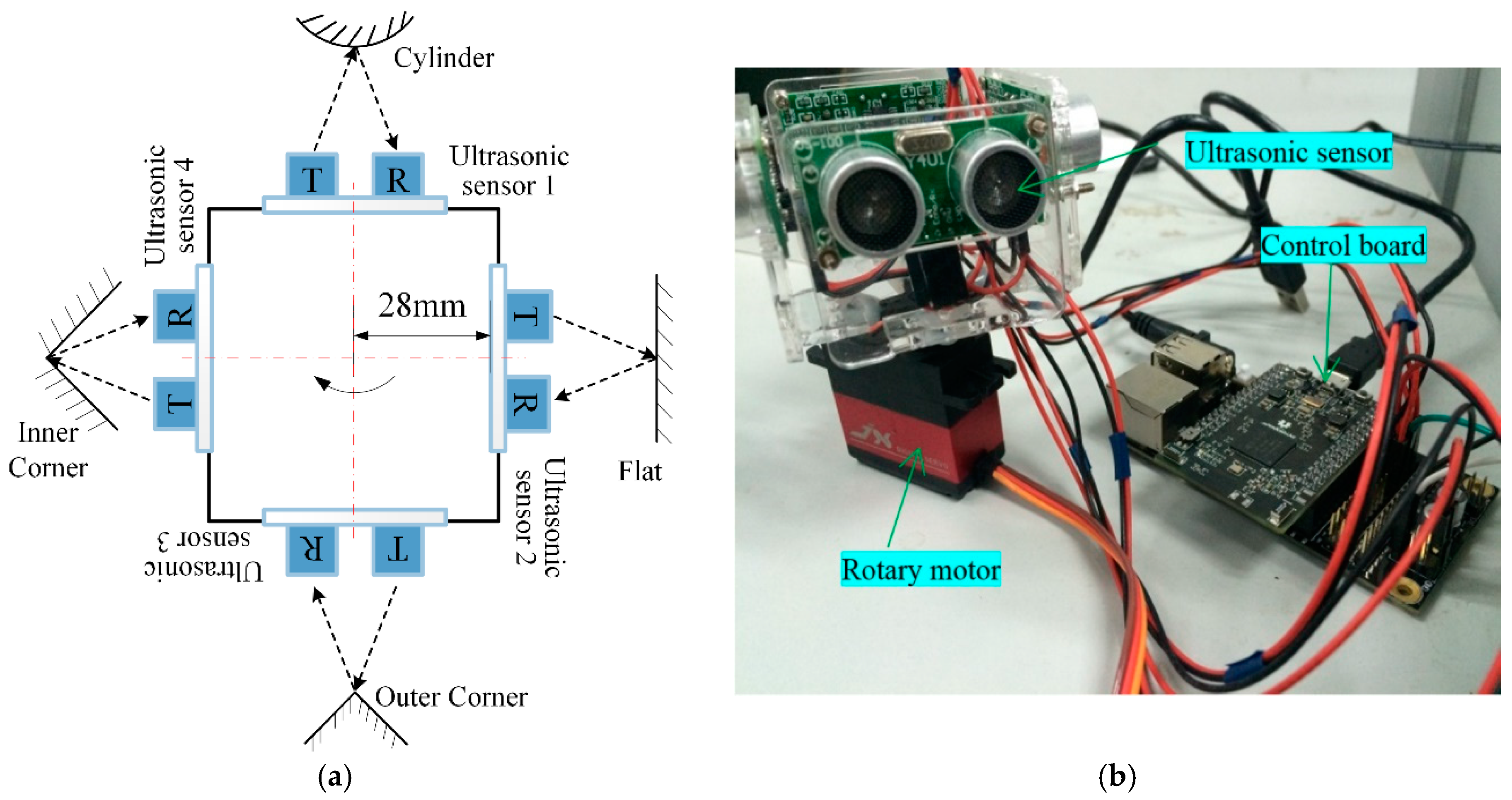
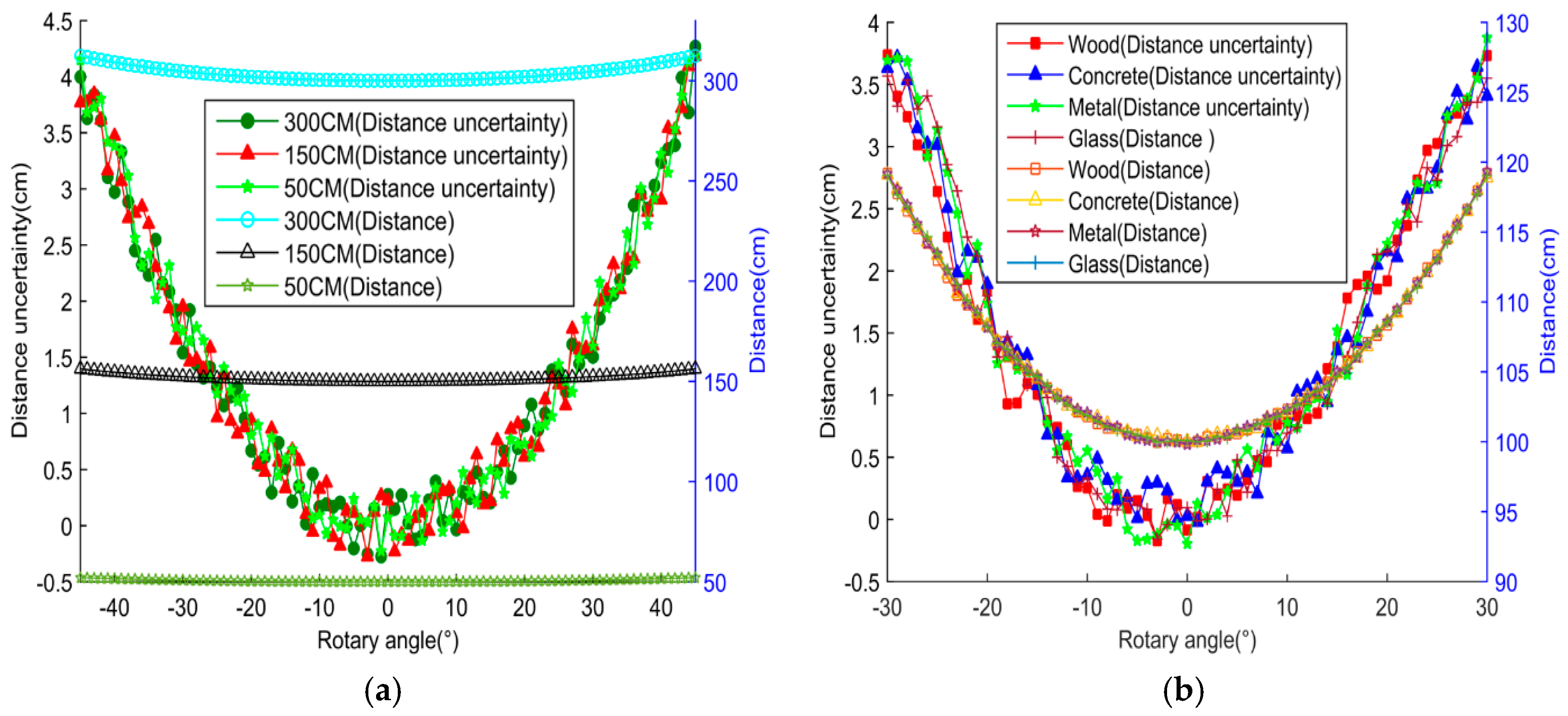

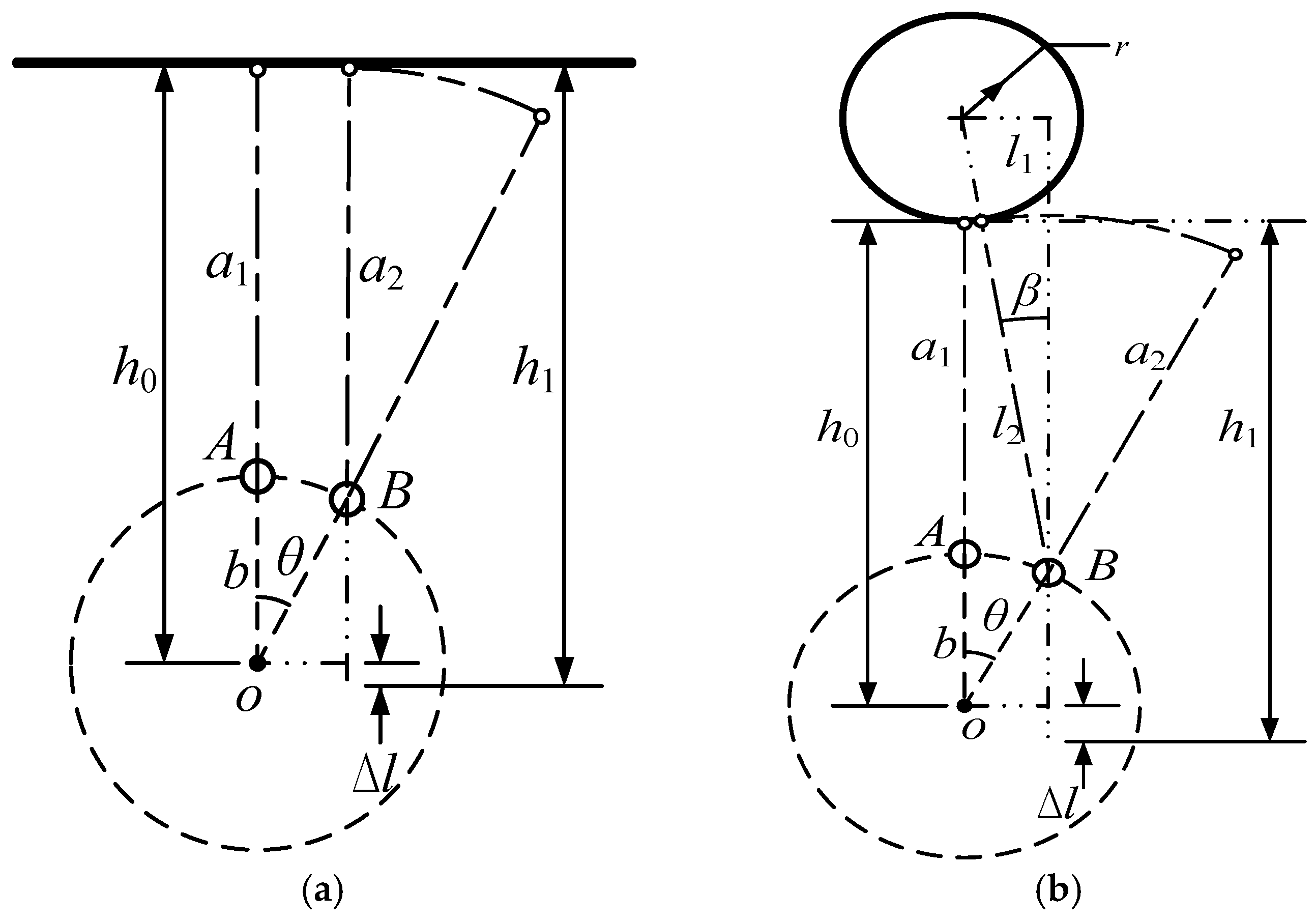



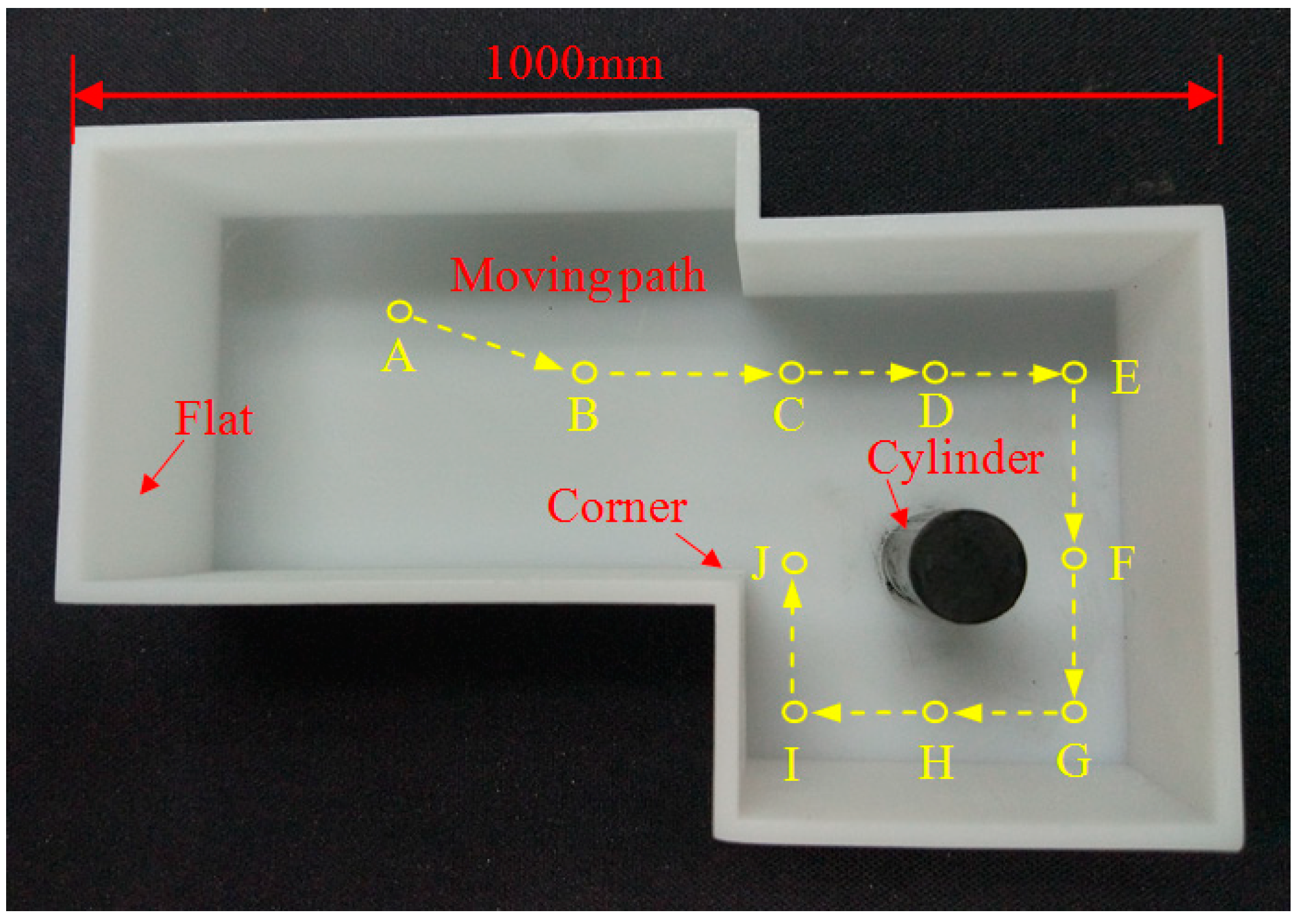
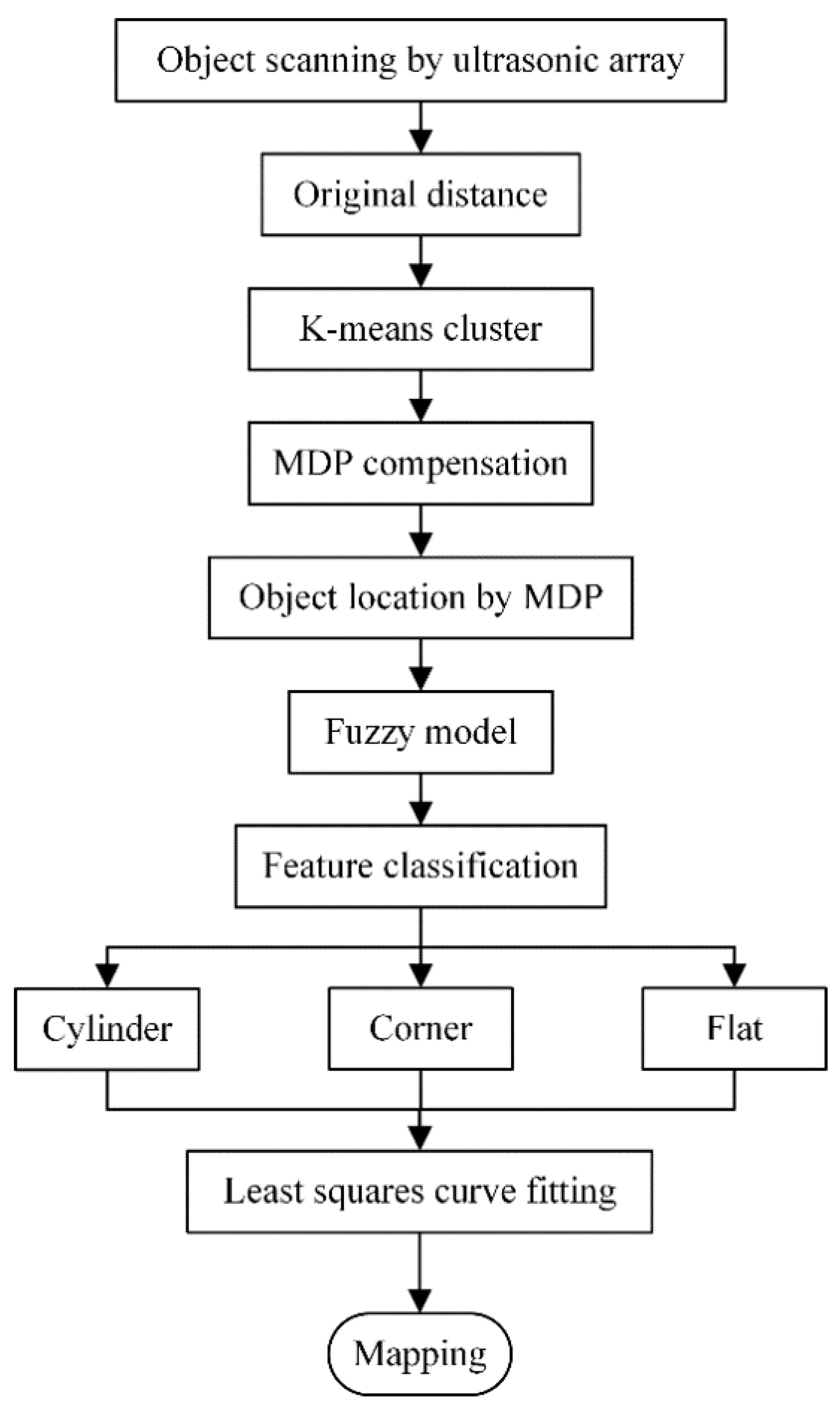
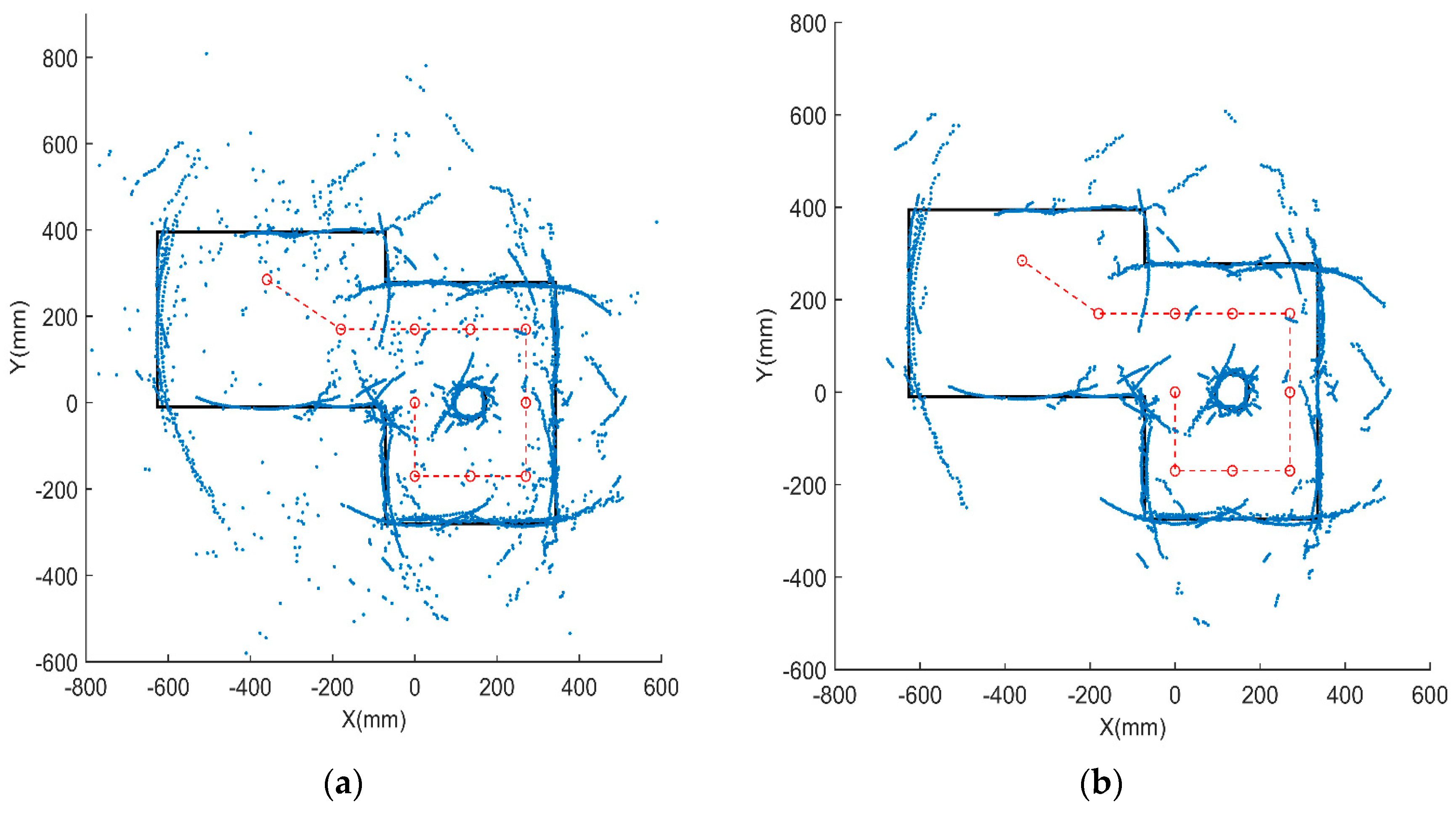
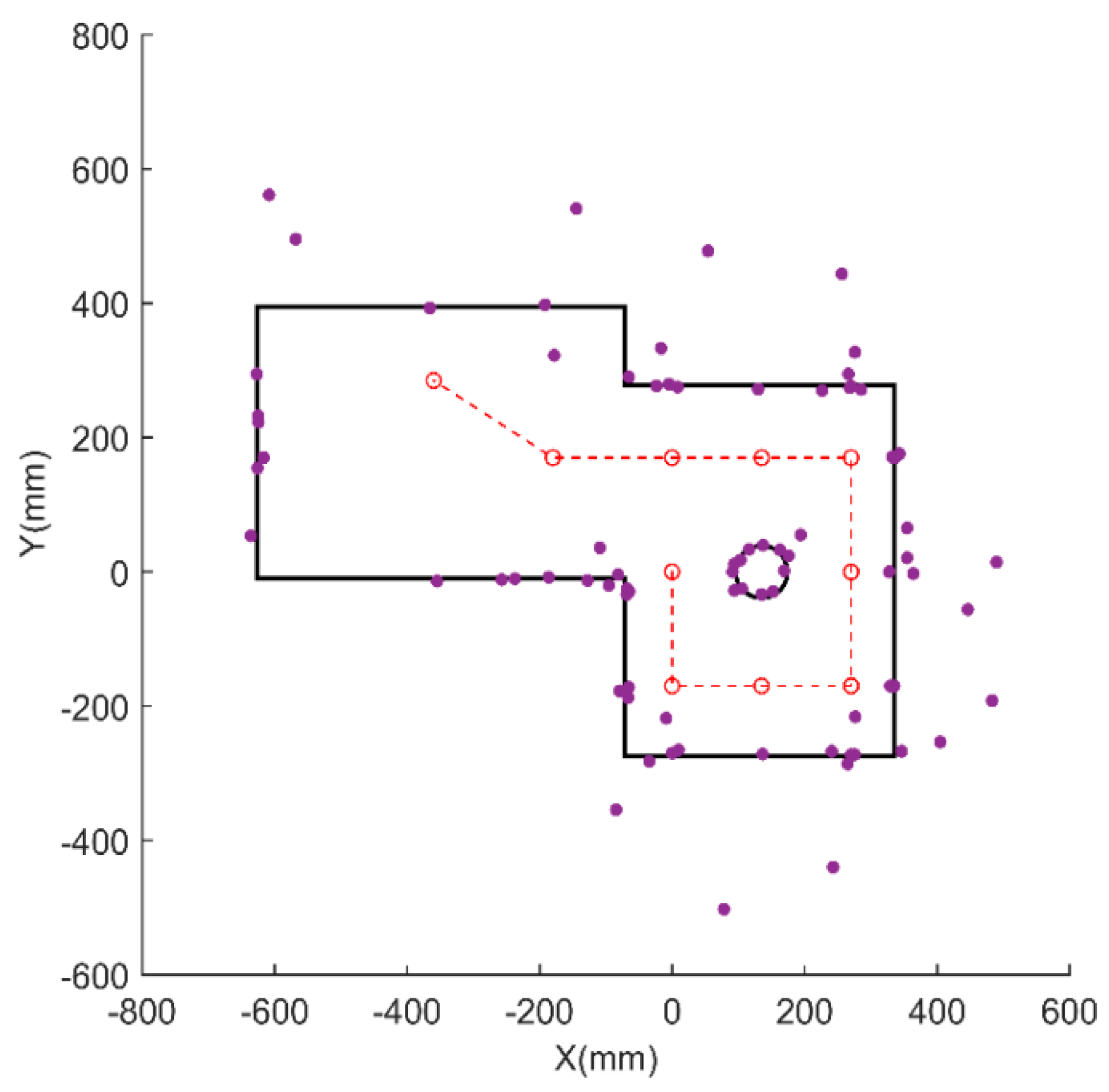
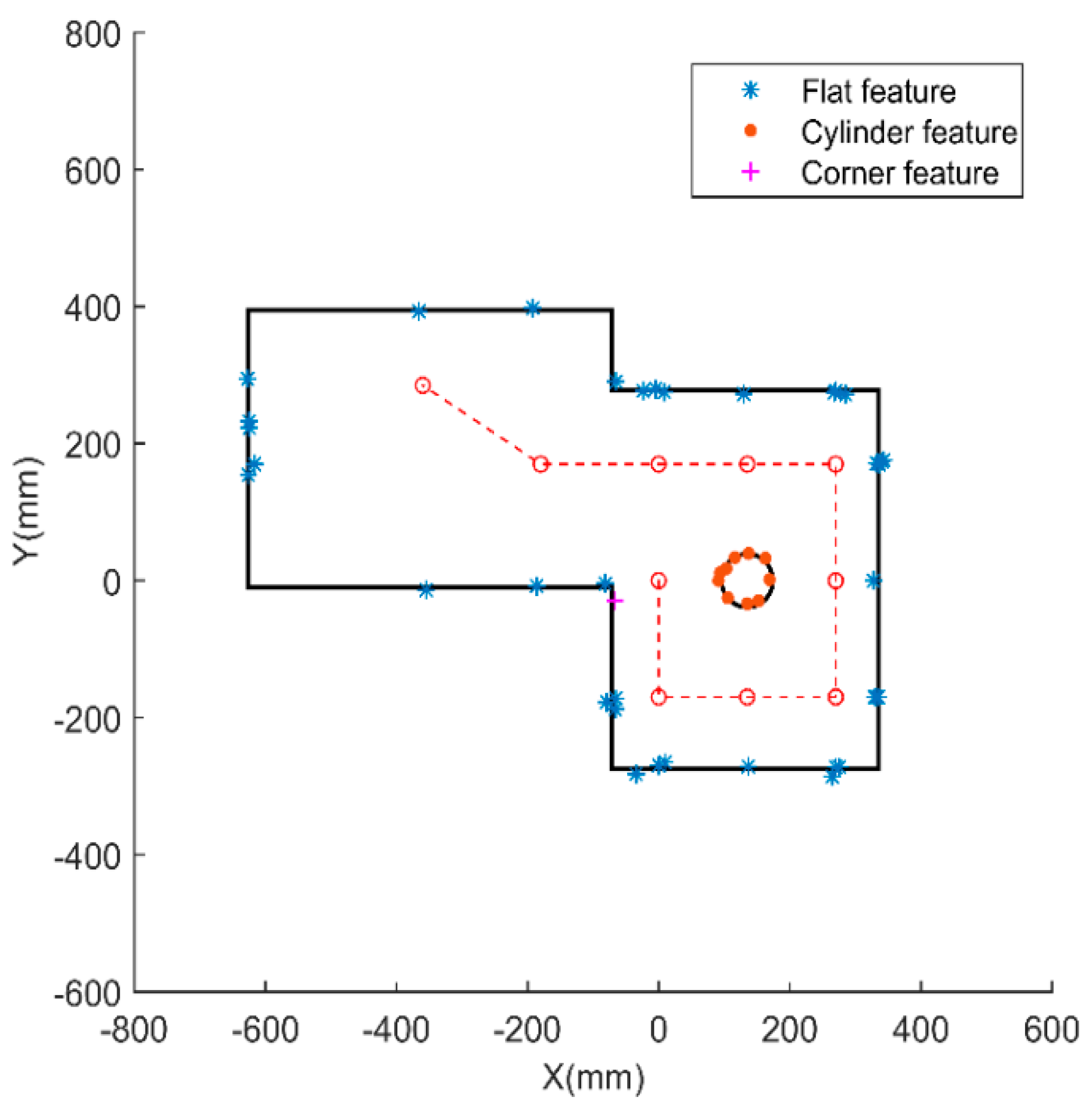
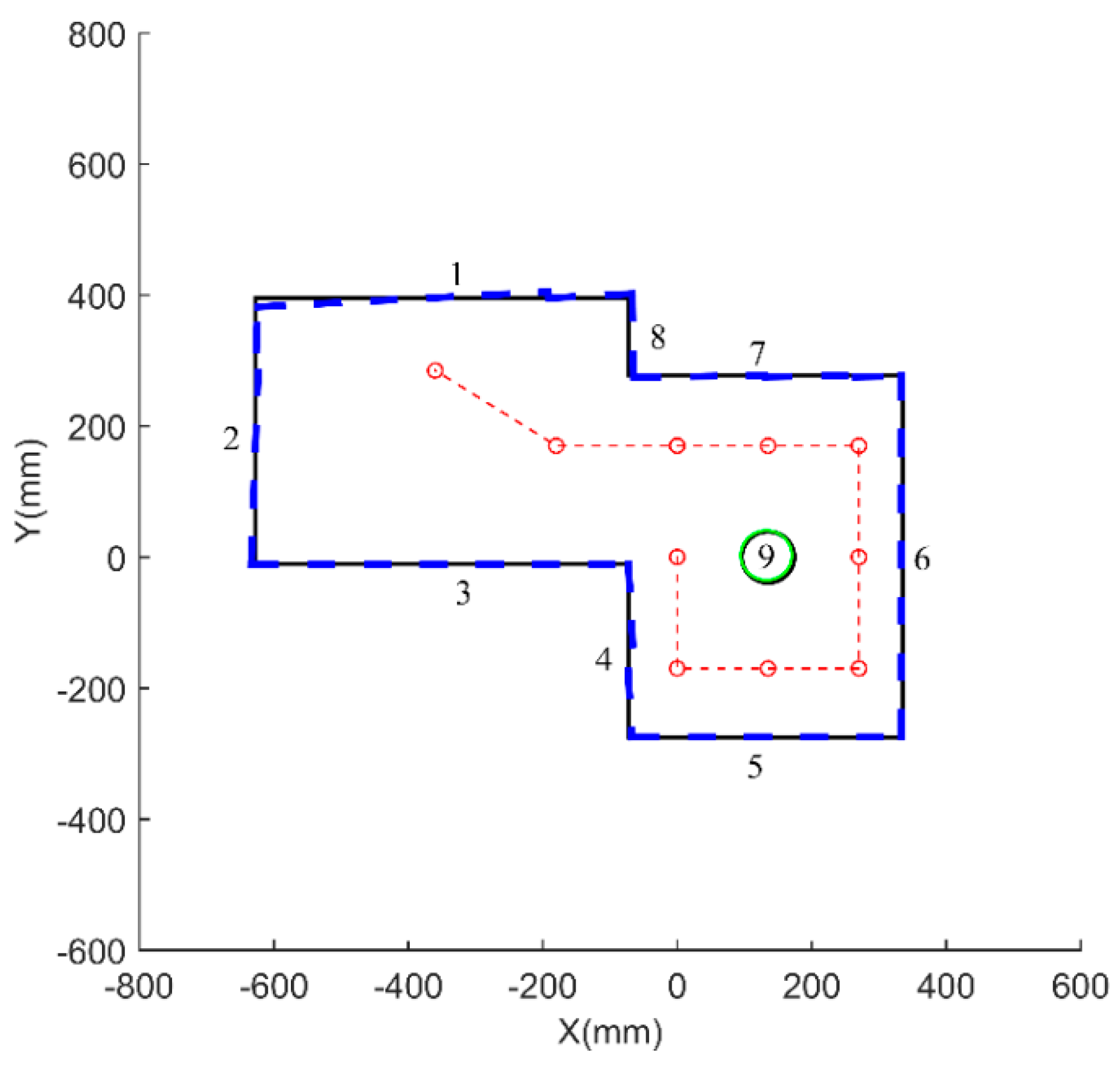
| State | Small | Medium | Big |
| Value | 0 | 1 | 2 |
| State | Non-Covering | Left Covering | Right Covering | Front Covering |
| Value | 0 | 1 | 2 | 3 |
| State | Corner | Cylinder | Flat |
| Value | 0 | 1 | 2 |
| Membership | Boundary State | ||||
|---|---|---|---|---|---|
| 0 | 1 | 2 | 3 | ||
| Ultrasonic distance range | 0 | μ0 | μ0 − 0.25 | μ0 − 0.25 | μ0 − 0.3 |
| μ1 | μ1 + 0.25 | μ1 + 0.25 | μ1 | ||
| μ2 | μ2 | μ2 | μ2 + 0.3 | ||
| 1 | μ0 | μ0 | μ0 | μ0 | |
| μ1 | μ1 − 0.2 | μ1 − 0.2 | μ1 − 0.3 | ||
| μ2 | μ2 + 0.2 | μ2 + 0.2 | μ2 + 0.3 | ||
| 2 | μ0 | μ0 | μ0 | μ0 | |
| μ1 | μ1 | μ1 | μ1 | ||
| μ2 | μ2 | μ2 | μ2 | ||
| Index | Distance Uncertainty (mm) | Angle Uncertainty (°) |
|---|---|---|
| 1 | 12.8 | 3 |
| 2 | 6.7 | 2 |
| 3 | 1.0 | 0 |
| 4 | 7.8 | 3 |
| 5 | 0.5 | 0 |
| 6 | 1.8 | 0 |
| 7 | 3.8 | 1 |
| 8 | 7.0 | 1 |
© 2018 by the authors. Licensee MDPI, Basel, Switzerland. This article is an open access article distributed under the terms and conditions of the Creative Commons Attribution (CC BY) license (http://creativecommons.org/licenses/by/4.0/).
Share and Cite
Long, Z.; He, R.; He, Y.; Chen, H.; Li, Z. Feature Extraction and Mapping Construction for Mobile Robot via Ultrasonic MDP and Fuzzy Model. Sensors 2018, 18, 3673. https://doi.org/10.3390/s18113673
Long Z, He R, He Y, Chen H, Li Z. Feature Extraction and Mapping Construction for Mobile Robot via Ultrasonic MDP and Fuzzy Model. Sensors. 2018; 18(11):3673. https://doi.org/10.3390/s18113673
Chicago/Turabian StyleLong, Zhili, Ronghua He, Yuxiang He, Haoyao Chen, and Zuohua Li. 2018. "Feature Extraction and Mapping Construction for Mobile Robot via Ultrasonic MDP and Fuzzy Model" Sensors 18, no. 11: 3673. https://doi.org/10.3390/s18113673
APA StyleLong, Z., He, R., He, Y., Chen, H., & Li, Z. (2018). Feature Extraction and Mapping Construction for Mobile Robot via Ultrasonic MDP and Fuzzy Model. Sensors, 18(11), 3673. https://doi.org/10.3390/s18113673





